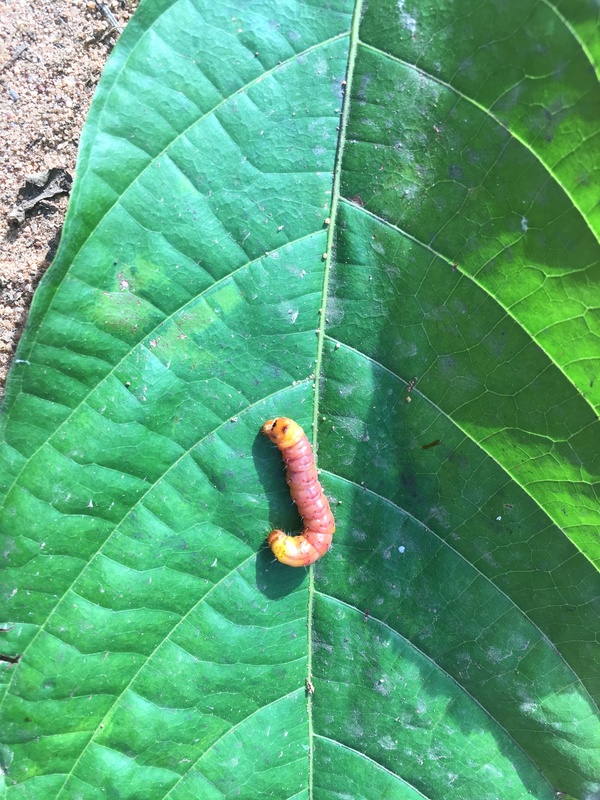Diseases and pests affecting cocoa plants in South India ( karnataka)
Cocoa (cacao) None Given
We have about 2500 cocoa plants, aged 2 years. Some of the plants are already having flowers and well grown. But it is very disheartening to see
1. Quite a few plants leaves are full of holes from some time.
2. And some trees are dying because of maggot infestation (we do see the puncture wounds on the plants stems and some droppings on the soil. When we slice open the plant we see the maggots inside).
What is the problem and how to control it?
1. Quite a few plants leaves are full of holes from some time.
2. And some trees are dying because of maggot infestation (we do see the puncture wounds on the plants stems and some droppings on the soil. When we slice open the plant we see the maggots inside).
What is the problem and how to control it?
Posted
by: Haravu Lokesh
(1 point)
![]()
Posted: December 11, 2016
Answers
Answer from Dec 11th at 1130pm EST
This is definitely a stem borer. It is either beetle or a moth. It looks remarkably similar to this one from Malaysia Agarwood (Figure 1). If it is caused by beetles you might see the adult (Figure 2) come down from the canopy during the day?
This is an extremely difficult problem to solve. The larvae are inside the tree and the application of chemicals is hard since they do not reach their target.
There is a record of a farmer in Ghana devising a suffocation method. As they saw the holes they sealed it up and suffocated the insect inside
http://scripts.farmradio.fm/radio-res...
Another method that is known to be useful is to encourage aggressive ants like Weaver ants that can prevent the adult moth or beetle from laying eggs.
You could try putting some insticded into the hole under pressure? I would try an organic insecticide like neem soap. You should first try this on some test saplings and see what happens.
..........
Answer from Dec 11th at 10:45pm EST
This sounds like a stem borer which for cocoa is a moth like Zeuzera coffeae. The adults are called leopard moths because of the pattern of dark bluish spots on a translucent white background on the forewings. It is the larvae that cause the problem.
"Sticky strings or groups of pale yellow eggs are laid on small stems and branches. No attempt is
made to hide them in bark cracks. After about 10- 11 days the eggs turn dark yellow-red before
hatching. The larvae stay together and spin a communal web. From this web each larva lowers
itself on silk threads. The threads are caught by the breeze and act as ‘parachutes’ and the larvae
can be carried considerable distances. The death-rate is very high at this stage, but a larva
lucky enough to land on a suitable host bores into the bark. Early tunnels may be formed in thin stems (petioles), which are later deserted for
hhicker stems. In cocoa the larvae tunnel up to 30cms along the centre of a branch and finally
makes a cross tunnel before pupation. The pupa sticks out of the entrance of the cross tunnel
before emergence."
http://www.cocoasafe.org/Resources%5C...
"MANAGEMENT
Cultural control
Pruning of infested branches does reduce stem borer populations but is labour intensive. Hand
picking of adults and removal of larvae using pieces of wire can achieve good results but it must start as soon as infestation is spotted. Also unfortunately this method can cause serious damage to the trees if not undertaken very carefully and its use should be strictly limited.
Planting of barrier crops such as dense stands of taro or sweet potato or Pueraria species has also
been suggested. The stands should be at least 15 m wide and established early for new plantings,
removing alternative host plants is also recommended.
Leucaena glauca has also been recommended as a barrier crop, however if left unmanaged it can become a pest because of its rapid growth and its ability to crowd out native vegetation.
Biological control
In Java, larvae of Z. coffeae are parasitised by Bracon zeuzerae (Hymenoptera). In Malaysia,
Eulophonotus myrmeleon larvae are parasitised by a Glyptomorpha (Hymenoptera). However, none
of the many parasites and predators of Pantorhytes has shown any promise of providing natural
control.
Live larvae are less likely to be found in trees foraged by the ants, but the introduction of ants into
cocoa orchards is difficult.
The fungus Beauveria bassiana infects larvae of Z. coffeae but there is no commercial product
available at present.
Woodpeckers will frequently peck out borers.
Chemical control
There is no effective chemical control that does not involve using highly toxic and expensive
chemicals.
Spraying highly toxic chemicals kills parasitic wasps such as Ichneumons (Hymenoptera). Spraying
stopped at the end of 1961 and by the end"
..............
We need more information. Please provide images of the trunk and flowers.
Do you see any insects on the leaves (also check at night).
Are you growing these under shade or in full sun?
Take a picture of the "maggots"
Posted
by: David Hughes
(67 points)
![]()
Posted: December 12, 2016
You need to log in if you'd like to add an answer or comment.







0 Comments